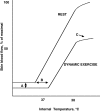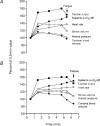The cardiovascular challenge of exercising in the heat
- PMID: 17855754
- PMCID: PMC2375553
- DOI: 10.1113/jphysiol.2007.142158
The cardiovascular challenge of exercising in the heat
Abstract
Exercise in the heat can pose a severe challenge to human cardiovascular control, and thus the provision of oxygen to exercising muscles and vital organs, because of enhanced thermoregulatory demand for skin blood flow coupled with dehydration and hyperthermia. Cardiovascular strain, typified by reductions in cardiac output, skin and locomotor muscle blood flow and systemic and muscle oxygen delivery accompanies marked dehydration and hyperthermia during prolonged and intense exercise characteristic of many summer Olympic events. This review focuses on how the cardiovascular system is regulated when exercising in the heat and how restrictions in locomotor skeletal muscle and/or skin perfusion might limit athletic performance in hot environments.
Figures

 and the plateau in cardiac output above 90% of
and the plateau in cardiac output above 90% of  (Mortensen et al. 2005). Filled symbols depict the cardiac output, systemic vascular conductance and systemic O2 delivery for the upper, middle, and lower panels, respectively. Open symbols depict the blood flow, vascular conductance and O2 delivery to the exercising legs for the respective panels.
(Mortensen et al. 2005). Filled symbols depict the cardiac output, systemic vascular conductance and systemic O2 delivery for the upper, middle, and lower panels, respectively. Open symbols depict the blood flow, vascular conductance and O2 delivery to the exercising legs for the respective panels.


 . Heat stress also reduced
. Heat stress also reduced  from 4.7 ± 0.2 to 4.3 ± 0.2 l min−1 despite equal maximal heart rates. Redrawn from González-Alonso & Calbet (2003).
from 4.7 ± 0.2 to 4.3 ± 0.2 l min−1 despite equal maximal heart rates. Redrawn from González-Alonso & Calbet (2003).
References
-
- Bangsbo J. Quantification of anaerobic energy production during intense exercise. Med Sci Sports Exerc. 1998;30:47–52. - PubMed
-
- Brengelmann GL. Circulatory adjustments to exercise and heat stress. Annu Rev Physiol. 1983;45:191–212. - PubMed
-
- Brengelmann GL, Johnson JM, Hermansen L, Rowell LB. Altered control of skin blood flow during exercise at high internal temperatures. J Appl Physiol. 1977;43:790–794. - PubMed
-
- Drust B, Rasmussen P, Mohr M, Nielsen B, Nybo L. Elevations in core and muscle temperature impair repeated sprint performance. Acta Physiol Scand. 2005;183:181–190. - PubMed
Publication types
MeSH terms
Grants and funding
LinkOut - more resources
Full Text Sources
Medical

